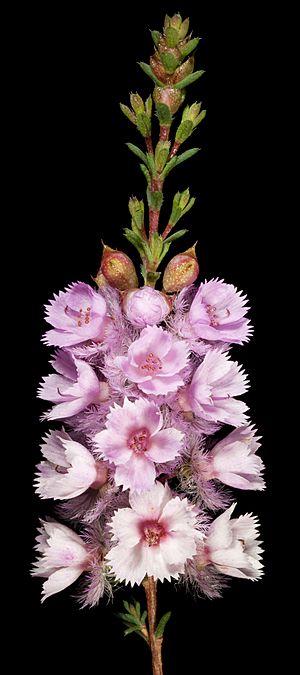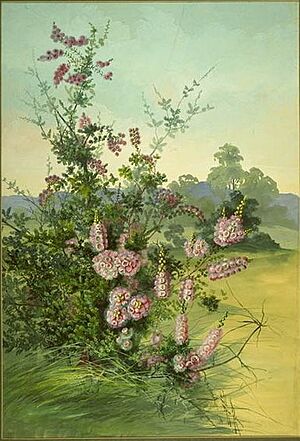Native tea facts for kids
Quick facts for kids Native tea |
|
|---|---|
 |
|
| V. pennigera in the Western Australian Herbarium | |
| Scientific classification | |
| Genus: |
Verticordia
|
| Species: |
pennigera
|
Verticordia pennigera, also known as native tea, is a beautiful flowering plant. It belongs to the myrtle family, called Myrtaceae. This plant grows only in the south-west part of Western Australia.
Native tea is usually a small bush. It can grow upright or spread out low on the ground. It has tiny leaves and pretty flowers that smell nice. These flowers are often pale pink to bright magenta. They bloom in the spring.
Contents
What Does Native Tea Look Like?
Verticordia pennigera is a type of shrub or bush. It often spreads out wide. This plant can grow from about 8 to 85 centimeters tall. It can also spread from 10 to 100 centimeters wide. It has several main stems with many short, leafy branches.
The leaves are thin and long, or shaped like an oval. They are about 2 to 4 millimeters long. These leaves are covered with fine, soft hairs.
The Flowers of Native Tea
The flowers of native tea have a light, pleasant smell. They grow in groups that look like spikes. Each flower sits on a small stalk, about 1.5 to 3 millimeters long.
The bottom part of the flower, called the floral cup, is shaped like a top. It is 2 to 3 millimeters long and smooth. It also has two small green parts that stick out.
The sepals are pale pink to magenta, matching the petals. They are about 3.5 to 4.5 millimeters long. They have 5 or 6 hairy parts and two small ear-like bits on the sides. The petals are similar in color. They are 3 to 5 millimeters long and stand upright. Their top edges have short, rough teeth.
The style is about 4.5 to 5 millimeters long. It is hairy near the tip. Native tea flowers bloom from September to December.

How Did Native Tea Get Its Name?
The plant Verticordia pennigera was first officially described in 1837. A scientist named Stephan Endlicher did this. He studied a plant sample found near the Swan River. This sample was collected by Charles von Hügel.
The name pennigera comes from a Latin word. It means "feather-bearer." This likely refers to the feathery look of some parts of the flower.
Where Does Native Tea Grow?
This type of verticordia plant usually grows in sandy or clay soils. These soils often have gravel or granite mixed in. You can find it in a large area of Western Australia. This area stretches from Kalbarri National Park down to the Bremer River area. It grows in many different natural regions.
Is Native Tea Protected?
The Western Australian Government's Department of Parks and Wildlife has looked at Verticordia pennigera. They have classified it as "not threatened." This means it is not currently in danger of disappearing.
Growing Native Tea at Home
There are many different types of native tea that people grow in their gardens. Some are open bushes with stiff stems. Others are low-growing and bushy. The flowers can also vary in size and color.
People usually grow new native tea plants from cuttings. This means taking a small piece of the plant and helping it grow roots. Some types of native tea grow well in areas that get a lot of rain in winter. All types grow best in a sunny spot with soil that drains water well.

